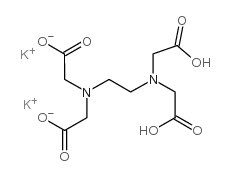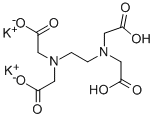乙二胺四乙酸二钾, 99%,Dipotassium EDTA
产品编号:西域试剂-WR380461| CAS NO:2001-94-7| 分子式:C10H14K2N2O8| 分子量:368.42
本网站销售的所有产品仅用于工业应用或者科学研究等非医疗目的,不可用于人类或动物的临床诊断或者治疗,非药用,非食用,
| 英文名称 | Dipotassium EDTA |
|---|---|
| CAS编号 | 2001-94-7 |
| 产品熔点 | 245ºC |
| 产品沸点 | 614.2ºC at 760mmHg |
| 产品密度 | 1.566g/cm3 |
| 产品闪点 | 325.2ºC |
| 精确质量 | 368.00200 |
| PSA | 161.34000 |
| 蒸气压 | 1.15E-16mmHg at 25°C |
相关文档
化学品安全说明书(MSDS)
下载MSDS质检证书(COA)
相关产品
Synonym:EDTA, Dipotassium Salt Dihydrate; (Ethylenedinitrilo)tetraacetic Acid, Dipotassium Salt Section 2 - COMPOSITION, INFORMATION ON INGREDIENTS
Risk Phrases: 36/37/38 Section 3 - HAZARDS IDENTIFICATION EMERGENCY OVERVIEW
Irritating to eyes, respiratory system and skin. Potential Health Effects Eye: Causes eye irritation. Skin: Causes skin irritation. Ingestion: Causes gastrointestinal irritation with nausea, vomiting and diarrhea. Methemoglobinemia is characterized by dizziness, drowsiness, headache, shortness of breath, cyanosis (bluish discoloration of skin due to deficient oxygenation of the blood), rapid heart rate and chocolate-brown colored blood. Exposure may cause kidney injury, muscle cramps, bone-marrow depression, and a generalized allergic reaction. Inhalation: Causes respiratory tract irritation. Methemoglobinemia is characterized by dizziness, drowsiness, headache, shortness of breath, cyanosis (bluish discoloration of skin due to deficient oxygenation of the blood), rapid heart rate and chocolate-brown blood. Chronic: May cause methemoglobinemia, which is characterized by chocolate-brown colored blood, headache, weakness, dizziness, breath shortness, cyanosis (bluish skin due to deficient oxygenation of blood), rapid heart rate, unconsciousness and possible death. Section 4 - FIRST AID MEASURES Eyes: Flush eyes with plenty of water for at least 15 minutes, occasionally lifting the upper and lower eyelids. Get medical aid. Skin: Immediately flush skin with plenty of water for at least 15 minutes while removing contaminated clothing and shoes. Get medical aid if irritation develops or persists. Wash clothing before reuse. Ingestion: Never give anything by mouth to an unconscious person. Treat symptomatically and supportively. Get medical aid. Do NOT induce vomiting. If conscious and alert, rinse mouth and drink 2-4 cupfuls of milk or water. Inhalation: Remove from exposure and move to fresh air immediately. If not breathing, give artificial respiration. If breathing is difficult, give oxygen. Get medical aid if cough or other symptoms appear. Notes to Physician: For methemoglobinemia, administer oxygen alone or with Methylene Blue depending on the methemoglobin concentration in the blood. Antidote: Methylene blue, alone or in combination with oxygen is indicated as a treatment in nitrite induced methemoglobinemia. Section 5 - FIRE FIGHTING MEASURES General Information: As in any fire, wear a self-contained breathing apparatus in pressure-demand, MSHA/NIOSH (approved or equivalent), and full protective gear. Dusts at sufficient concentrations can form explosive mixtures with air. During a fire, irritating and highly toxic gases may be generated by thermal decomposition or combustion. Extinguishing Media: Use water spray, dry chemical, carbon dioxide, or appropriate foam. Section 6 - ACCIDENTAL RELEASE MEASURES General Information: Use proper personal protective equipment as indicated in Section 8. Spills/Leaks: Clean up spills immediately, observing precautions in the Protective Equipment section. Sweep up, then place into a suitable container for disposal. Avoid generating dusty conditions. Carefully scoop up and place into appropriate disposal container. Provide ventilation. Section 7 - HANDLING and STORAGE Handling: Wash thoroughly after handling. Remove contaminated clothing and wash before reuse. Minimize dust generation and accumulation. Avoid contact with eyes, skin, and clothing. Keep container tightly closed. Avoid ingestion and inhalation. Use with adequate ventilation. Wash clothing before reuse. Storage: Do not store in direct sunlight. Store in a tightly closed container. Store in a cool, dry, well-ventilated area away from incompatible substances. Section 8 - EXPOSURE CONTROLS, PERSONAL PROTECTION Engineering Controls: Facilities storing or utilizing this material should be equipped with an eyewash facility and a safety shower. Use adequate ventilation to keep airborne concentrations low. Exposure Limits CAS# 2001-94-7: CAS# 25102-12-9: Personal Protective Equipment Eyes: Wear appropriate protective eyeglasses or chemical safety goggles as described by OSHA's eye and face protection regulations in 29 CFR 1910.133 or European Standard EN166. Skin: Wear appropriate protective gloves to prevent skin exposure. Clothing: Wear appropriate protective clothing to prevent skin exposure. Respirators: A respiratory protection program that meets OSHA's 29 CFR 1910.134 and ANSI Z88.2 requirements or European Standard EN 149 must be followed whenever workplace conditions warrant respirator use. Section 9 - PHYSICAL AND CHEMICAL PROPERTIES Physical State: Solid Color: white Odor: none reported pH: 5.2 Vapor Pressure: Not available. Viscosity: Not available. Boiling Point: Not applicable. Freezing/Melting Point: Not applicable. Autoignition Temperature: Not applicable. Flash Point: Not available. Explosion Limits, lower: Not available. Explosion Limits, upper: Not available. Decomposition Temperature: 272 deg C Solubility in water: soluble (20 C) Specific Gravity/Density: Not available. Molecular Formula: C10H14N2O8K2.2H2O Molecular Weight: 404.33 Section 10 - STABILITY AND REACTIVITY Chemical Stability: Stable at room temperature in closed containers under normal storage and handling conditions. Decarboxylates above 150C. Conditions to Avoid: Incompatible materials, dust generation, excess heat. Incompatibilities with Other Materials: Strong oxidizing agents. Hazardous Decomposition Products: Nitrogen oxides, carbon monoxide, carbon dioxide, ammonia and/or derivatives, nitrogen. Hazardous Polymerization: Has not been reported. Section 11 - TOXICOLOGICAL INFORMATION RTECS#: CAS# 2001-94-7: AH4310000 CAS# 25102-12-9 unlisted. LD50/LC50: CAS# 2001-94-7: Draize test, rabbit, eye: 100 mg; Draize test, rabbit, skin: 500 mg Mild. CAS# 25102-12-9. Carcinogenicity: Dipotassium ethylenediaminetetraacetate anhydrous - Not listed by ACGIH, IARC, or NTP. Dipotassium ethylenediaminetetraacetate dihydrate - Not listed by ACGIH, IARC, or NTP. Other: See actual entry in RTECS for complete information. Section 12 - ECOLOGICAL INFORMATION Ecotoxicity: Catfish (tap water) 129ppm/96H. Section 13 - DISPOSAL CONSIDERATIONS Products which are considered hazardous for supply are classified as Special Waste and the disposal of such chemicals is covered by regulations which may vary according to location. Contact a specialist disposal company or the local waste regulator for advice. Empty containers must be decontaminated before returning for recycling. Section 14 - TRANSPORT INFORMATION IATA No information available. IMO No information available. RID/ADR No information available. Section 15 - REGULATORY INFORMATION European/International Regulations European Labeling in Accordance with EC Directives Hazard Symbols: XI Risk Phrases: R 36/37/38 Irritating to eyes, respiratory system and skin. Safety Phrases: S 26 In case of contact with eyes, rinse immediately with plenty of water and seek medical advice. S 37/39 Wear suitable gloves and eye/face protection. WGK (Water Danger/Protection) CAS# 2001-94-7: 1 CAS# 25102-12-9: No information available. Canada CAS# 2001-94-7 is listed on Canada's DSL List. CAS# 2001-94-7 is not listed on Canada's Ingredient Disclosure List. CAS# 25102-12-9 is not listed on Canada's Ingredient Disclosure List. US FEDERAL TSCA CAS# 2001-94-7 is listed on the TSCA inventory. CAS# 25102-12-9 is not listed on the TSCA inventory. It is for research and development use only. SECTION 16 - ADDITIONAL INFORMATION N/A |








 浙公网安备 33010802013016号
浙公网安备 33010802013016号